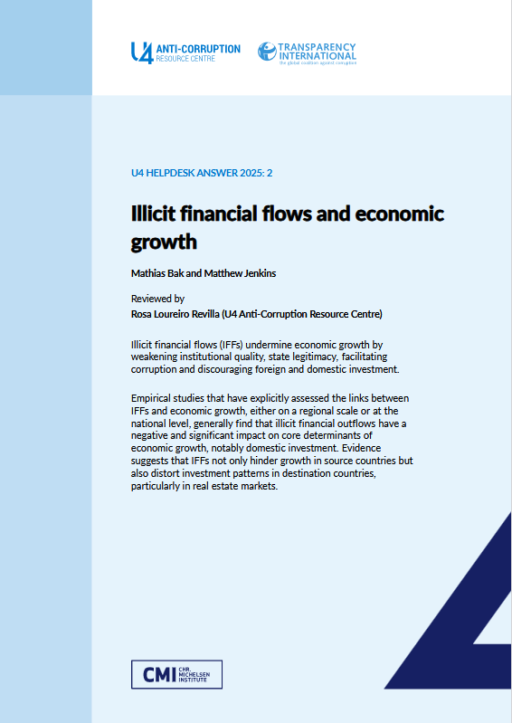
This Anti-Corruption Helpdesk brief was produced in response to a query from a U4 Partner Agency. The U4 Helpdesk is operated by Transparency International in collaboration with the U4 Anti-Corruption Resource Centre based at the Chr. Michelsen Institute.
Query
Please provide a literature review of studies that empirically assess the impact of illicit financial flows on economic growth.
Summary
Illicit financial flows (IFFs) undermine economic growth by weakening institutional quality, state legitimacy, facilitating corruption and discouraging foreign and domestic investment.
Empirical studies that have explicitly assessed the links between IFFs and economic growth, either on a regional scale or at the national level, generally find that illicit financial outflows have a negative and significant impact on core determinants of economic growth, notably domestic investment. Evidence suggests that IFFs not only hinder growth in source countries but also distort investment patterns in destination countries, particularly in real estate markets.
Main points
- There is significant variation in how IFFs are defined and, as a result, measured. These conceptual and methodological differences have important implications for estimates of the scale of IFFs and attempts to analyse their effects on economic growth.
- Using time-series panel data (data that tracks multiple entities, like countries or companies, over a period of time) to assess the impact of the estimated volume of illicit outflows on GDP growth and domestic investment is the most common method to evaluate how IFFs relate to economic performance.
- Despite well-documented methodological shortcomings (Nitsch 2016; Johannesen and Pirttilä 2016; Collin 2020: 55), Global Financial Integrity’s estimates of IFFs are widely used to model the economic impact of illicit flows. The structural impact of IFFs in macroeconomic terms is a growing field of study, and the majority of studies examine the consequences of IFF outflows on source countries (also known as origin countries).
- This literature review reveals an emerging consensus that illicit outflows damage economic growth, productivity and socio-economic development in source countries. There are three major reasons for this: illicit financial outflows have significant negative effects on domestic revenue mobilisation, reduce private capital accumulation and discourage private and public investment.
- In turn, this hinders structural transformation and reduces public spending on critical sectors like education and healthcare, all of which can have knock-on effects on economic growth.
- Studies that have applied so-called financing gap models, such as the incremental capital output ratio (ICOR), to estimate the potential opportunity cost of illicit financial outflows conclude that these lost funds could have contributed significantly to higher economic growth in IFF source countries (Almounsor 2017; Fisseha 2022; Mpenya et al. 2015; Ndikumana 2014).
- IFFs’ effects on economic growth are more significant in the long run than in the short term, pointing to the negative cumulative effect of illicit financial outflows over time (Kasongo 2022: 1; Effiom et al. 2020: 358).
- Significantly less work has been conducted on the economic effects of IFFs on transit and destination countries. Nevertheless, some empirical studies indicate that illicit financial inflows can lead to inefficient investment patterns and asset inflation (particularly in real estate).
- Evidence suggests that quality of governance and control of corruption matters to counter IFFs and to mitigate their potential negative effects. Economic damage from IFFs appears less severe in situations with strong institutions and governance frameworks.
Contents
- Defining illicit financial flows
- Determinants of economic growth
- Methods to estimate the scale of IFFs
- Macroeconomic imbalances methods
- Trade-based IFF estimation methods
- IFF estimations based on discrepancies between assets and liabilities
- Phantom FDI
- Gravity modelling
- Firm-level data
- Other ways of estimating IFFs
- How IFFs could impact economic growth
- Synthesis of evidence of IFFs on economic growth
- Summaries of selected studies examining the impact of IFFs and capital flight on economic growth
- References
Caveats
This Helpdesk Answer surveys the literature to present original studies of the empirical relationship between IFFs and economic growth. The literature review looked for evidence on the effects of IFFs on source, transit and destination countries, but found that most of the research focuses on source countries.
The Helpdesk Answer attempts to apply some appraisal of the quality and robustness of the studies included. However, the authors note that, due to the sophisticated nature of statistical models employed in many of the studies considered, ascertaining the reliability of the methodologies used and the viability of some of the research findings reported would require a thorough examination of each study by a skilled econometrist.
Finally, this literature review tried to prioritise studies that used a ‘narrow’ conceptualisation of IFFs and capital flight that excludes what UNCTAD refers to as legal activities, such as tax avoidance and legal forms of profit shifting. However, the authors of some of the studies included did not clearly specify the exact definition of IFFs they employed when assessing the impact on economic growth.
Authors
Mathias Bak and Matthew Jenkins
Reviewers
Rosa Loureiro Revilla (U4 Anti-Corruption Resource Centre)
Date
16/01/2025
Tags
 Download PDF
Download PDF
